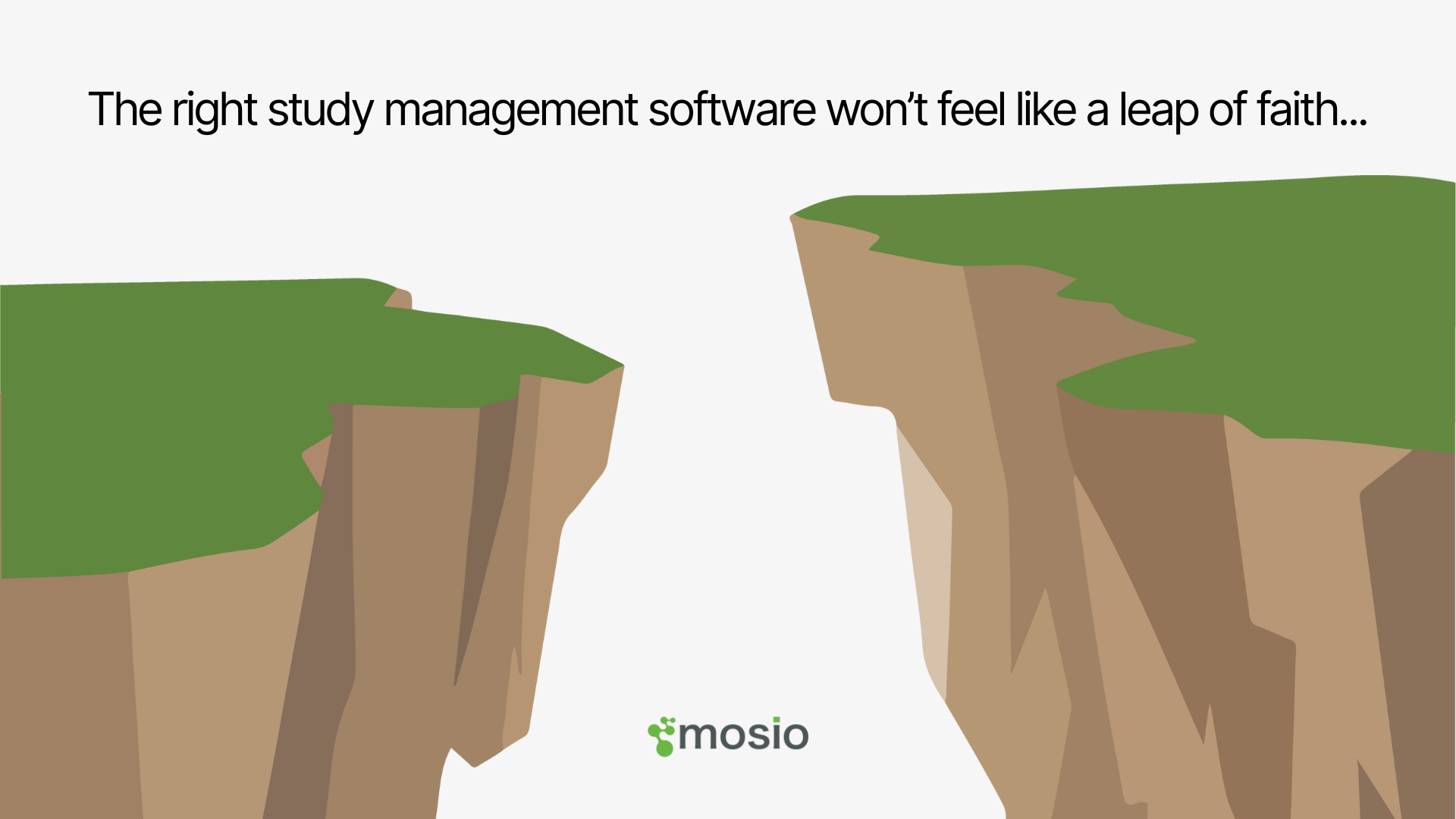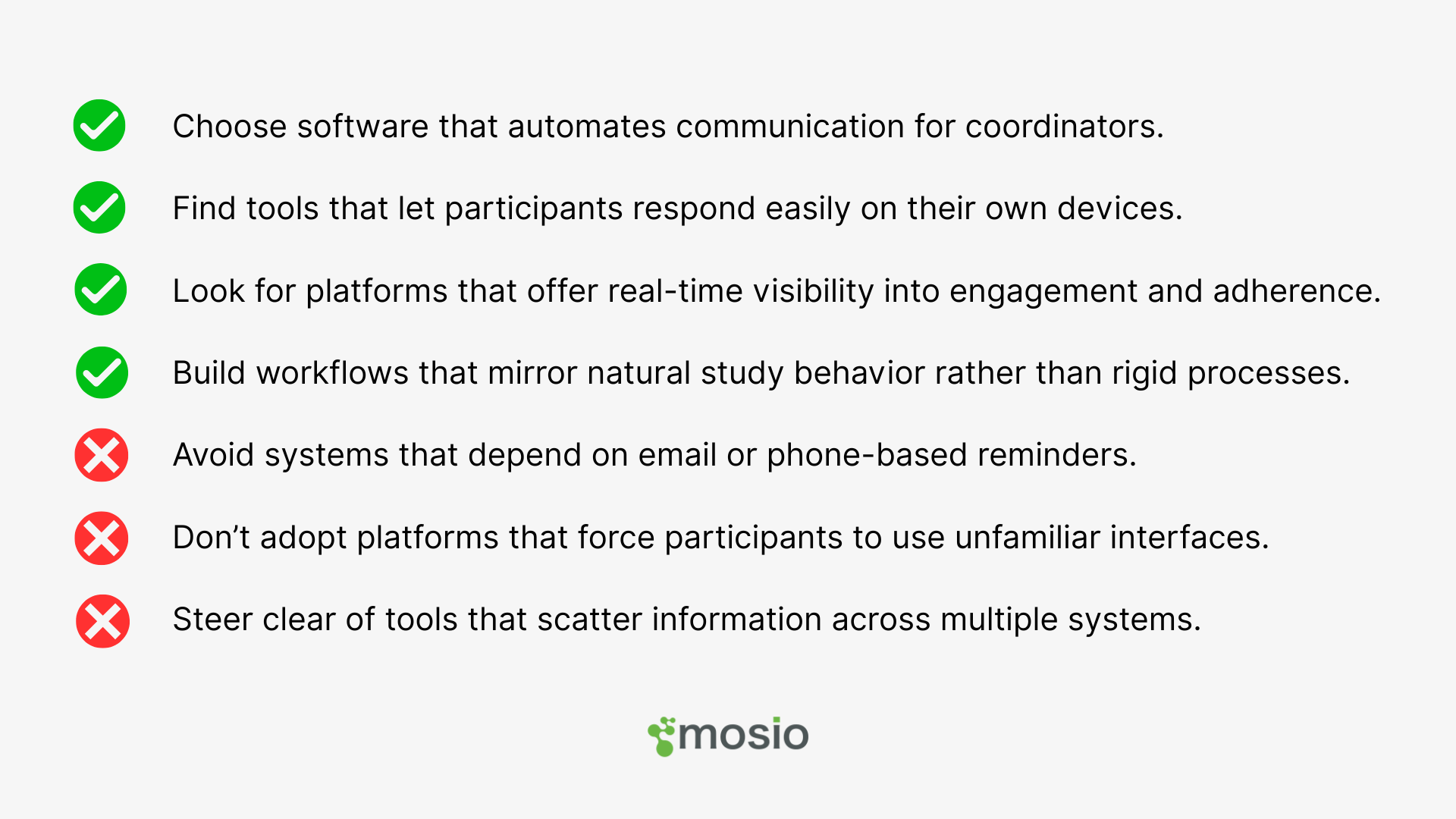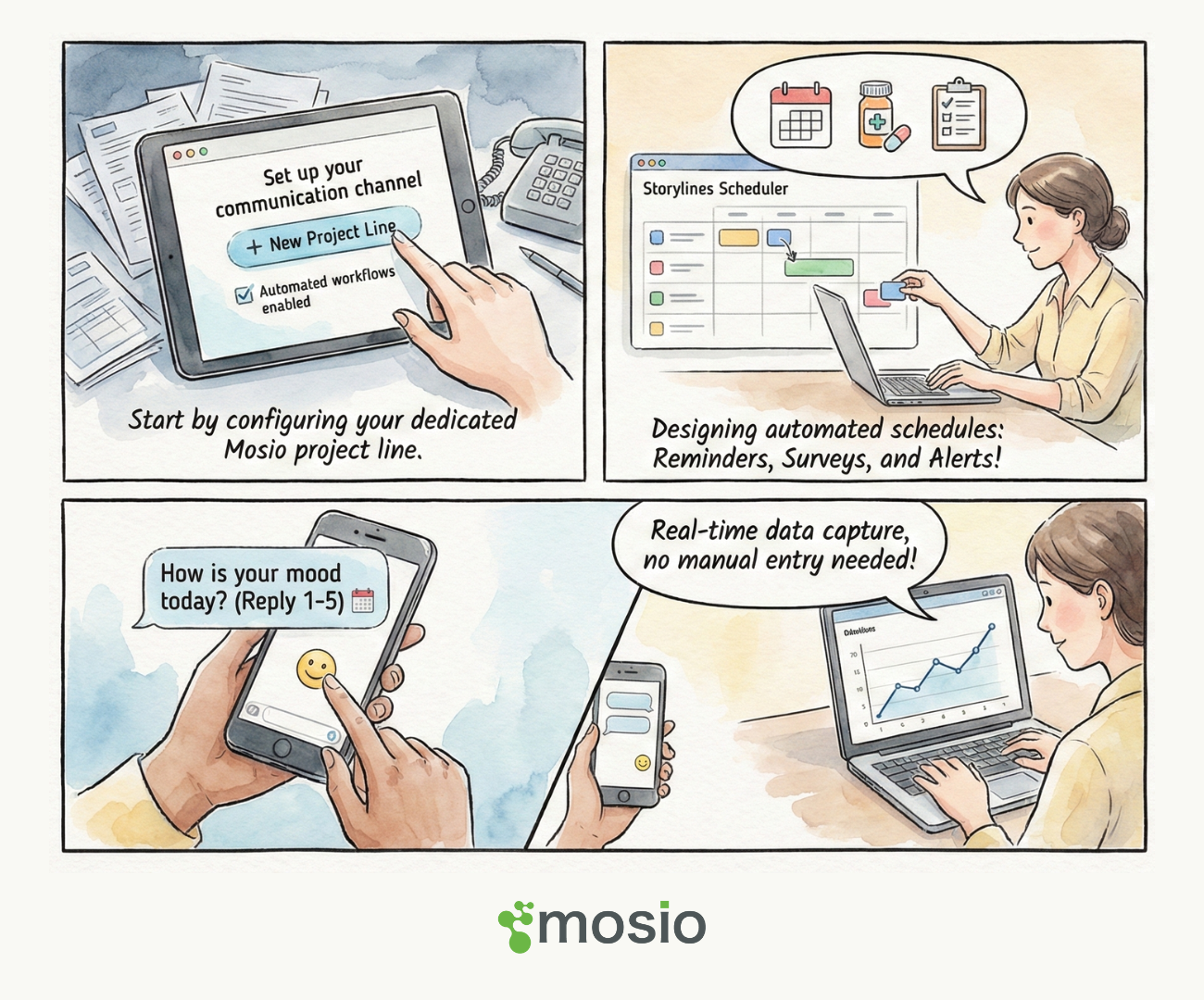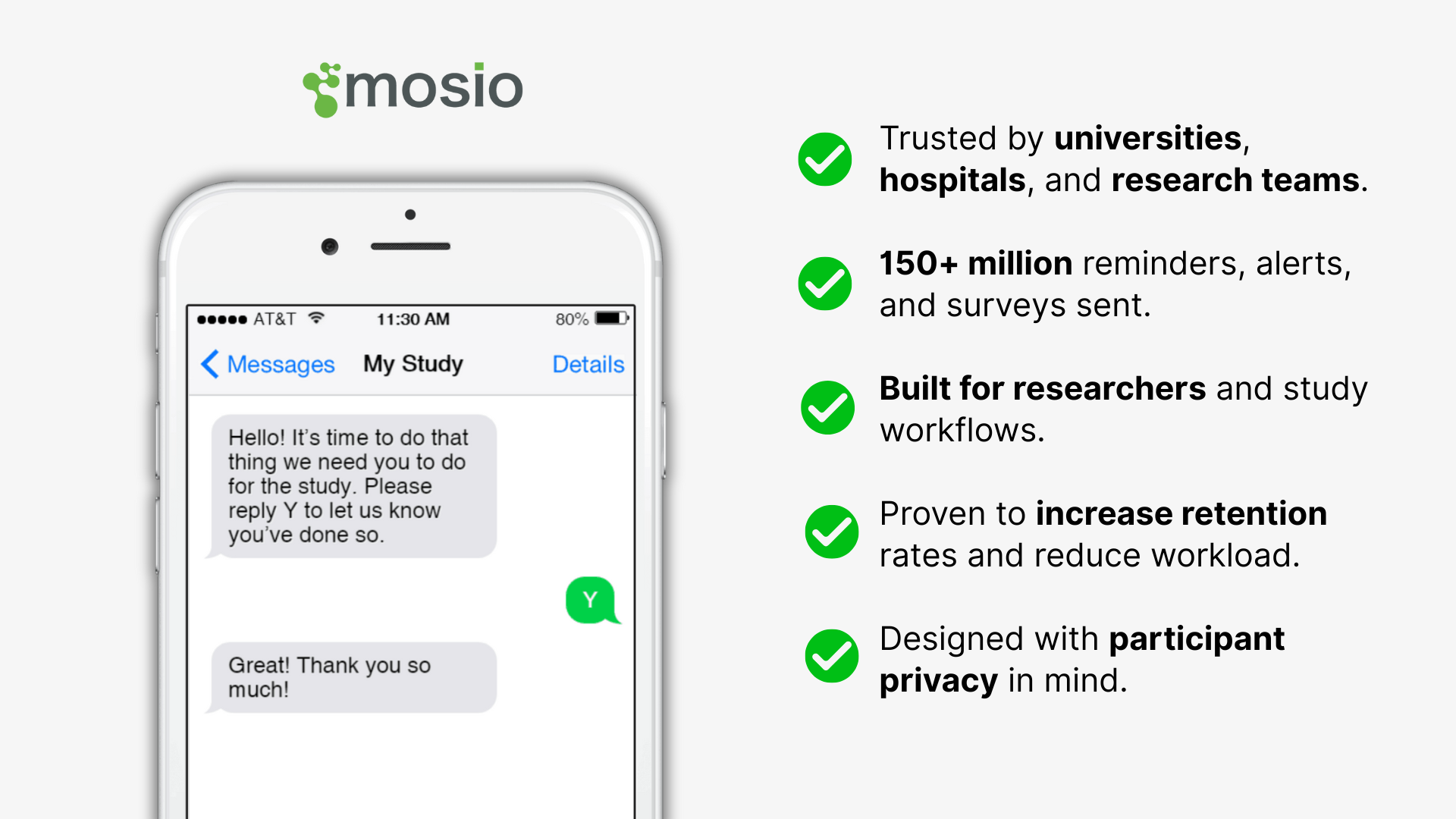Study management software is supposed to simplify the chaos of research, but too often it introduces friction and confusion.
Before we get into what works for researchers, here are a few quick things to avoid when evaluating your options:
- Tools that rely heavily on email or phone-based follow-up.
- Systems that require manual data entry or repetitive reminders.
- Platforms with steep learning curves for participants or study staff.
- Anything that makes real-time visibility difficult.
When teams adopt study management software that supports automation, consistent communication, and participant-friendly engagement, the entire research process flows more smoothly. At Mosio, we’ve seen firsthand how the right tools reduce coordinator workload, improve adherence, and remove the friction that typically slows studies down.
The studies that thrive do so because their systems are built around simplicity. Participants need easy ways to respond, while coordinators want real-time information at their fingertips.
When those two elements align, studies stay on schedule, data arrives cleanly, and staff finally get to focus on higher-level responsibilities rather than chasing participants or troubleshooting avoidable drop-offs.
After scrolling through this article, if you feel a sense of relief, knowing your next study doesn’t have to suffer from preventable communication breakdowns, take this as a sign to book a demo of Mosio. We’ll tell you more about our text messaging software for researchers soon.
Study Management Software That Actually Reduces Workloads
Research teams need systems that create consistency without adding administrative overhead. Software with strong automation capabilities does this best, especially when communication is a core function.
Participants stay more engaged when instructions arrive naturally on their mobile devices. Text messages outperform calls and emails in both speed and completion rate because they’re seen immediately. Automated reminders fill in the gaps, making sure that key tasks, like completing surveys, reporting symptoms, or confirming appointments, don’t fall through.
When I speak with researchers, they need a platform that mirrors on-site communication patterns through automated sequences. Mosio is designed specifically for this purpose. Study teams can schedule reminders, alerts, and touchpoints that run quietly in the background while still allowing room for personalized interaction when necessary.
A structured software-supported workflow might include:
- Timely medication or activity reminders
- Appointment confirmations with follow-up if someone cancels
- Survey invitations sent at precise intervals
Coordinators can track progress as the responses come in. They can identify participants who may need additional support. This preserves the feel of on-site engagement while removing the repetitive manual work that normally consumes hours.
Mosio’s Storylines module was built to simplify these automated pathways. Once set up, they manage day-to-day communication on their own. Participants feel guided and supported, and coordinators maintain consistent retention without scrambling behind the scenes.
When that level of automation is in place, research teams stop spending time chasing participants and start making progress on the parts of their studies that truly matter.
Data Quality Depends On Two Important Elements
Can you guess what they are?
Data quality comes down to clarity and convenience. When a system forces participants to log in to portals or use unfamiliar apps, entry rates drop and datasets become uneven.
Mosio eliminates this friction by supporting electronic patient-reported outcomes (ePRO) and data collection through text messaging. Participants submit responses directly from their phones.
We’ve found that this familiarity increases compliance dramatically. Tasks that might be delayed through email are completed quickly via text. Automated “nudges” close the loop if participants forget, which reduces the gap between scheduled and completed entries.
As a researcher, you can trigger surveys by time, activity, or event-based conditions. This means the system adapts to genuine participant behavior rather than a rigid calendar.
Across studies, we’ve seen that:
- Text-based surveys return faster, more consistent data.
- Fewer responses need cleanup or follow-up.
- Coordinators gain earlier visibility into adherence patterns.
Automated exports connect with REDCap and other data systems. This will give analysts clean datasets without the usual manual consolidation that frustrates teams and eats into their time.
What’s The Secret To Keeping Participants Motivated?
Retention starts the moment someone enrolls. That’s the attitude of the best very research coordinators.
The fewer obstacles they encounter, the more likely they are to stay engaged for the duration of the study.
Mosio helps maintain that continuity through automated onboarding flows, scheduled reminders, personalized messages, and optional educational content. Coordinators can tailor communication to each stage of the study.
These messages might include things like:
- Early onboarding guidance
- Mid-study adherence reinforcement
- Late-stage survey encouragement or progress summaries
Personalization variables (like participant names or coordinator identifiers) create a familiar, supportive connection. Participants feel seen, even though communication is automated.
We’ve seen many studies boost retention by pairing SMS surveys with timely follow-up triggers. When a missed task is followed by a quick reminder, completion rates rise significantly. That timing acts as a digital stand-in for in-person staff oversight.
What you’ll find is that the system becomes a natural extension of your research team. Mosio can handle routine interactions automatically and escalate only when human intervention is needed.
What’s Usage Across Hundreds Of Studies Taught Us?
Our work with research groups across universities, hospitals, CROs, and public health organizations has shown us that success comes from systems that prioritize three things:
- Consistent, mobile-friendly communication.
- Automation that reduces cognitive and administrative load.
- Simplicity for both participants and coordinators.
Participants respond faster to text than any other channel, and completion rates surge when instructions are conversational rather than formal.
Researchers who configure automated sequences early experience fewer issues later. When the system is taking care of timing, escalation paths, and delivery, you can have staff focus on the strategic parts of the study rather than all of the repetitive stuff.
Can You Afford Not To Keep Every Participant Engaged?
Of course, you can’t!
“Finally, someone made this easy.”
That’s what one coordinator told us after switching to Mosio. They had spent months dealing with no-shows, delayed surveys, and endless follow-ups before realizing that automation could make a real difference in these areas.
Your research team has far more important things to do than resend reminders or chase participation. Mosio is going to handle this heavy lifting quietly and reliably in the background for you.


![Study Management Software: Best & Worst Options [Tried & Tested]](https://www.mosio.com/wp-content/uploads/2023/04/national-cancer-institute-NFvdKIhxYlU-unsplash-scaled.jpg)








